Is Wood Flooring Good in Kitchens?
March 12, 2024 | By Bruce Product Expert
On one side, some folks believe that with a little effort, hardwood flooring is a perfect addition to a kitchen. They cite its classic appearance and overall durability.
Conversely, some folks worry that their wood floors face too many risks from spills, dents, scratches, and exposure to water threats. So, they fear the floors face too many obstacles to risk using it as a kitchen flooring option.
Kitchens arguably take the most beating of any other flooring surface in your home. Dropped pots. Spilled soda. Sink splashes. Pet accidents. And generally, there is a substantial amount of foot traffic.
So, what’s the answer? Can you use wood flooring in kitchens? And if so, what’s the best wood flooring for kitchens?
Wood Floors Are Trending for Kitchen Design
Wood flooring is becoming a popular choice for kitchen design. Why?
You can start with its natural beauty. Few flooring types add wood’s charm, elegance, and timeless appeal. Hardwood floors look incredible and add value to your home to boot.
Looks aside, wood floors just feel different. They’re warm and inviting, comfortable underfoot. Other flooring solutions like ceramic tile, brick, or stone have a cold, hard surface.
Wood Floors Protect Against Bacteria
Why is that important? Bacteria thrive in grout, which is necessary for installing tile, brick, and stone flooring.
Grout is porous, trapping dirt, moisture, and bacteria. And kitchens are notorious for bacteria.
Charles Gerba is a public health, environmental science, and immunology professor at the University of Arizona. Here’s what he has to say about kitchens and bacteria.
Known as Dr. Germ, he notes, “There’s more fecal bacteria in your kitchen sink than there is in a toilet after you flush it.”
That’s a disgusting thought. But it’s why you need a flooring surface that is less prone to house and capture bacteria. Wood floors fit the bill.
Wood doesn’t harbor as many allergens or allow bacteria to grow like other flooring. The caveat, of course, is that you spend some time cleaning them. For example, experts often recommend wood flooring for allergy sufferers.
Select a Wood Species with a High Janka Rating
Now, not every type of wood flooring fits kitchens. For instance, avoiding softer hardwoods like pine and cherry that scratch and dent more readily is best. You should select wood flooring with a good Janka rating, typically 1290 or higher.
In case you aren’t familiar, the Janka rating measures a wood’s hardness. Some hardwood floors have a harder surface than others.
For example, hickory is the hardest domestic wood, rating 1820. Maple is next at 1450, and white oak comes in a close third at 1360. Red oak is the median at 1290.
The harder the wood, the better its durability. And that’s a positive for kitchen flooring. Your wood floors will handle scratches, dents, and dog nails and endure the daily rigors of an active kitchen.
Solid Hardwoods in Kitchens
Solid hardwood is a staple for many. Folks have used it in homes for centuries.
As the name implies, each plank is one solid piece of wood. Oak flooring is a standby for many homeowners with its traditional flare. For more adventurous homeowners, hickory flooring adds a character all to itself.
The downside to solid wood flooring is its water resistance. It has little, and there’s always a risk of getting water on your floor in kitchens.
Water on Solid Hardwoods
When exposed to too much water, the wood swells and can begin to cup. Even humidity can make the floors expand and contract.
That’s not to say you can’t use solid wood flooring in a kitchen. If you do, however, start with a solid Janka rating. That will guard against pots dropping and denting your hardwood.
And be mindful of spills. You’ll want to wipe them up sooner than later.
But with some attention, solid hardwood flooring in the kitchen works perfectly fine. And here’s another important consideration. You can sand and refinish solid wood multiple times, extending its life by decades.
Engineered Wood Flooring in Kitchens
For added protection against spills, you can replace solid hardwood with engineered hardw. You still get compelling wood floors but with a twist.
Engineered hardwood flooring uses a solid wood veneer wear layer on its surface. However, its core consists of compressed plywood. That core enhances the plank’s structural integrity, making it less prone to expanding and contracting.
The net result is that your wood floors gain water resistance versus solid hardwoods. And that’s a plus in your kitchen.
Engineered Hardwood Can Add Style to Your Kitchen Design
Many engineered hardwoods include an aluminum oxide finish. That finish is one of the hardest available and substantially improves scratch and dent resistance.
Engineered wood comes in the same species as solid hardwoods. You can also get the flooring with finishes like hand-scraping or wire-brushing. And wide planks are common with this type of flooring.
Waterproof Wood Flooring in Kitchens
You read that correctly. Yes, there is waterproof wood flooring. For example, Bruce® manufactures Hydropel™ 100% waterproof wood floors, removing the concern for spills altogether.
Each side of the plank — top, bottom, sides, and ends — receives a waterproof treatment. It ensures top-down moisture protection for 36 hours.
Moreover, the treatment increases the wood’s Janka rating. For instance, Hydropel has a rating of 2500, making it even harder than standard hickory. As a result, your wood floors can handle more daily wear and tear.
And the flooring comes with a 50-year residential warranty.
Maintaining Your Kitchen Floors
Regardless of the kitchen wood flooring you choose, maintenance is essential.
First, remember the bacteria. Even though wood flooring offers a cleaner surface than grouted flooring, it still needs regular cleaning.
Vacuum or dry mop your kitchen floors routinely to remove debris that could mar your floor’s surface. You can use a damp mop sparingly with engineered hardwood and waterproof wood flooring. Make sure you ring it out thoroughly before wiping your floors.
Second, if you encounter a spill, wipe it up immediately to prevent it from staining the floor or seeping into the wood.
Third, a little added protection goes a long way. Use throw rugs in higher-traffic areas of your kitchen. They’ll protect your wood floors from wear and grit damage.
Use rubber mats where you have a greater risk of spills. They’ll prevent water splashes from hitting your kitchen floor, especially around your sink.
So, Can You Use Wood Floors in Your Kitchen?
Absolutely! They’re a great addition to your kitchen with their beauty and ability to handle high-traffic areas. And they add value during resale.
Count on Bruce for all types of wood flooring, from solid and engineered to waterproof and wood alternatives like rigid core.
Best of all, you can see how our floors look using our flooring visualizer. Take a picture of your kitchen, select one of our stylish floors, and see how it looks instantly. It removes any guesswork from flooring selection.
You can purchase Bruce wood flooring at a local retailer near you.

Ready to shop for hickory flooring near you?
Use our retail locator to find where you can buy Bruce oak flooring.
Find a Store
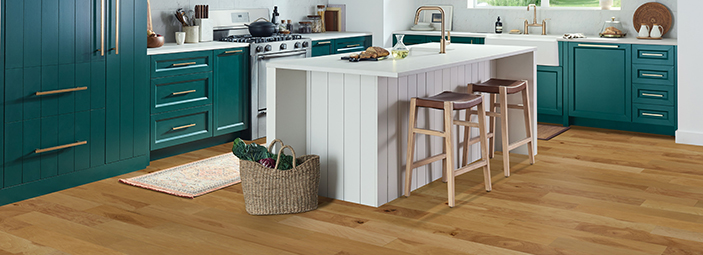
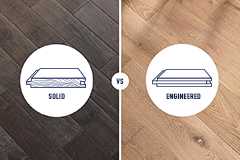 Solid vs Engineered Hardwood Flooring
Solid vs Engineered Hardwood Flooring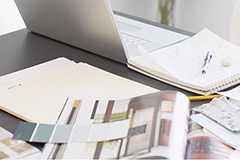 Guide To Choosing a Hardwood Floor
Guide To Choosing a Hardwood Floor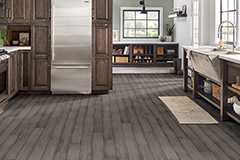 Hardwood Flooring Room Inspiration Guide
Hardwood Flooring Room Inspiration Guide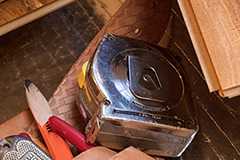 10 Things to Know About Hardwood Floor Installation
10 Things to Know About Hardwood Floor Installation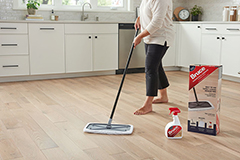 How To Clean and Protect Hardwood Flooring
How To Clean and Protect Hardwood Flooring